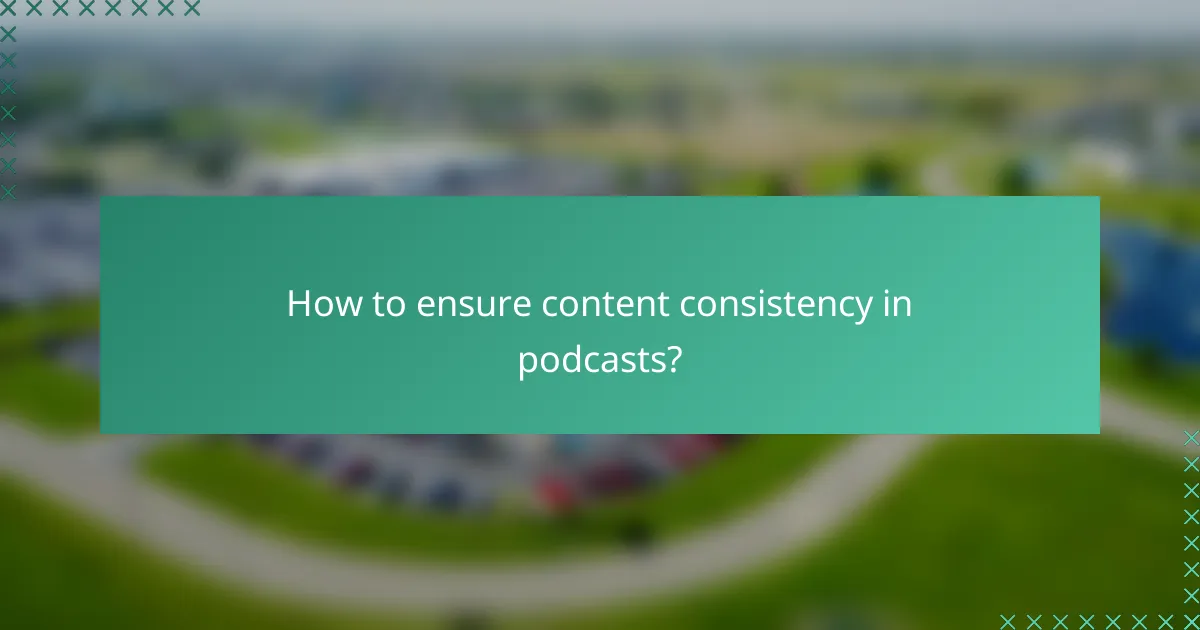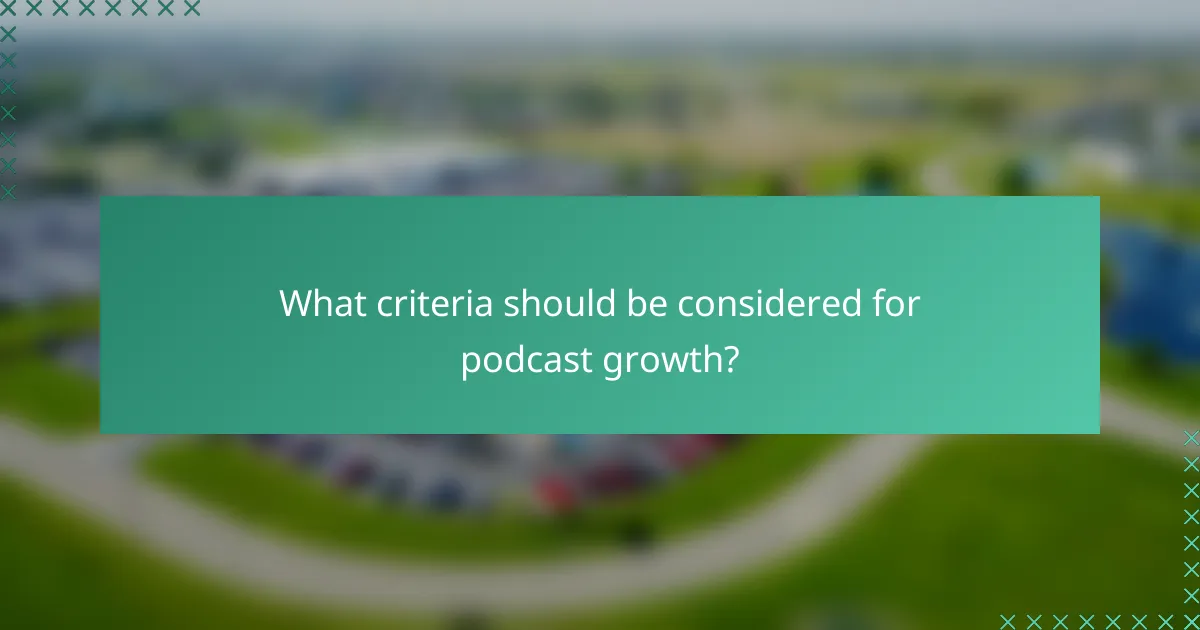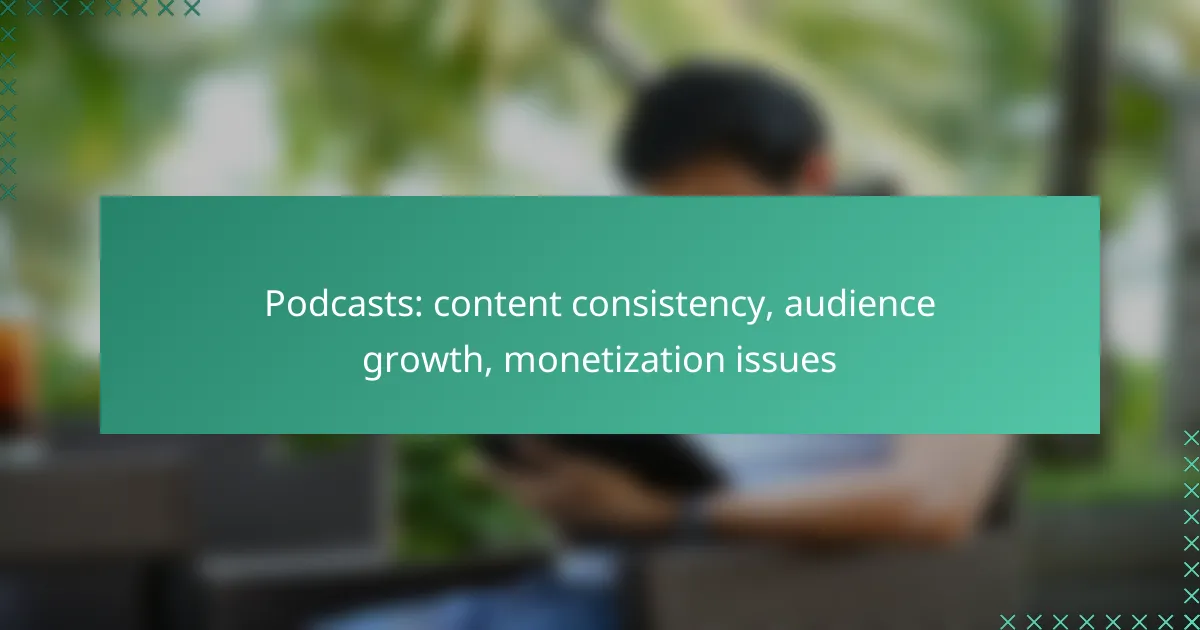Podcasts have become a powerful medium for storytelling and information sharing, but achieving success requires careful attention to content consistency, audience growth, and monetization strategies. By establishing a reliable schedule and engaging with listeners, creators can build trust and foster loyalty. Additionally, exploring diverse monetization avenues can help sustain and grow a podcast’s revenue potential.

How to ensure content consistency in podcasts?
To ensure content consistency in podcasts, establish a reliable schedule, plan your content strategically, maintain quality control, integrate audience feedback, and adhere to brand voice guidelines. These practices help build listener trust and foster audience growth.
Regular episode scheduling
Regular episode scheduling is crucial for maintaining audience engagement. Aim for a consistent release frequency, whether weekly, bi-weekly, or monthly. This predictability allows listeners to anticipate new content, which can lead to increased loyalty.
Consider using a content calendar to plan your episodes in advance. This tool can help you visualize your schedule and ensure that you meet your deadlines without overwhelming yourself or your team.
Content planning frameworks
Implementing a content planning framework can streamline your podcast production process. Frameworks like the Story Circle or the Hero’s Journey can provide structure to your episodes, ensuring that each one has a clear narrative arc.
Additionally, outline your episodes in advance, detailing key themes and topics. This approach not only helps maintain consistency but also makes it easier to adapt to audience interests over time.
Quality control processes
Establish quality control processes to maintain high production standards. This can include reviewing audio quality, editing for clarity, and ensuring that content aligns with your podcast’s goals. Regularly checking these elements can prevent inconsistencies that may alienate listeners.
Consider creating a checklist for each episode that covers technical aspects, content relevance, and overall flow. This practice can help ensure that every episode meets your established quality benchmarks.
Audience feedback integration
Integrating audience feedback is essential for maintaining relevance and consistency in your podcast. Encourage listeners to share their thoughts through surveys, social media, or direct messages. This input can guide your content decisions and help you address any inconsistencies.
Regularly review feedback and look for patterns or common themes. This analysis can inform future episodes and ensure that you are meeting the needs and expectations of your audience.
Brand voice guidelines
Establishing brand voice guidelines helps ensure that your podcast maintains a consistent tone and style. Define key elements such as language, humor, and formality to create a cohesive listening experience. This consistency reinforces your brand identity and builds trust with your audience.
Share these guidelines with your team and refer to them during production. Regularly revisit and update them as your podcast evolves to ensure they remain relevant and reflective of your audience’s preferences.

What strategies drive audience growth for podcasts?
Effective strategies for driving audience growth in podcasts include leveraging social media, collaborating with influencers, optimizing for search engines, and engaging listeners through surveys. These approaches not only enhance visibility but also foster a loyal listener base.
Social media promotion
Social media promotion is crucial for increasing a podcast’s reach. Platforms like Instagram, Twitter, and Facebook allow podcasters to share episode highlights, behind-the-scenes content, and engage with listeners directly. Regularly posting updates and utilizing relevant hashtags can significantly boost visibility.
Consider creating shareable graphics or short audio clips to entice potential listeners. Engaging with followers through comments and direct messages can also build a community around your podcast.
Collaborations with influencers
Collaborating with influencers can expand your podcast’s audience by tapping into their established follower base. Identify influencers who align with your podcast’s theme and audience, and propose guest appearances or cross-promotions. This can introduce your content to new listeners who may be interested in your niche.
When approaching influencers, ensure your pitch highlights mutual benefits, such as exposure for both parties. This strategy can lead to increased downloads and a more engaged audience.
SEO optimization techniques
SEO optimization techniques are essential for making your podcast discoverable in search engines. Use relevant keywords in your episode titles, descriptions, and show notes to improve search rankings. Additionally, creating a dedicated website for your podcast can enhance visibility and provide a platform for additional content.
Consider using tools like Google Keyword Planner to identify popular search terms related to your podcast’s topics. Regularly updating your website with blog posts or transcripts can also improve SEO performance.
Engagement through listener surveys
Engaging listeners through surveys can provide valuable insights into their preferences and interests. Use tools like Google Forms or SurveyMonkey to create simple surveys that ask for feedback on episode topics, format, and frequency. This not only shows that you value their opinions but can also guide future content creation.
Incentivizing participation with giveaways or shout-outs can increase response rates. Analyzing survey results can help tailor your podcast to better meet audience expectations, ultimately driving growth.

How to monetize podcasts effectively?
To monetize podcasts effectively, creators can explore various strategies such as sponsorships, listener donations, merchandise sales, and subscription models. Each method has its own advantages and considerations that can significantly impact revenue generation.
Sponsorship opportunities
Sponsorships involve partnering with brands that pay to have their products or services promoted during podcast episodes. This can be done through pre-recorded ads, host-read endorsements, or product placements. The key is to align with brands that resonate with your audience to maintain authenticity.
When seeking sponsorships, consider your listener demographics and engagement levels. Rates can vary widely, often based on audience size and niche, typically ranging from a few hundred to several thousand dollars per episode. Always ensure transparency with your audience about sponsored content.
Listener donations via Patreon
Platforms like Patreon allow listeners to support their favorite podcasts directly through monthly subscriptions. Creators can offer exclusive content, early access to episodes, or special perks to incentivize donations. This model fosters a community feeling and strengthens listener loyalty.
To maximize donations, clearly communicate the value of the content provided. Consider setting tiered donation levels to cater to different budgets, ranging from a few dollars to more substantial contributions. Regularly engaging with patrons can enhance their commitment and support.
Merchandise sales
Merchandise sales involve creating and selling branded products such as t-shirts, mugs, or stickers related to the podcast. This not only generates revenue but also promotes the podcast through fans wearing or using the products. Quality design and relevance to your content are crucial for success.
Start by identifying products that resonate with your audience and consider using print-on-demand services to minimize upfront costs. Pricing should reflect production costs while remaining accessible to your listeners. Promote merchandise through your episodes and social media to drive sales.
Subscription models
Subscription models allow listeners to pay for premium content, such as ad-free episodes, bonus material, or exclusive series. This approach can create a steady revenue stream and enhance the listener experience. Platforms like Apple Podcasts and Spotify offer built-in subscription features for ease of use.
When implementing a subscription model, clearly define what exclusive content subscribers will receive. Pricing should be competitive, often ranging from a few dollars per month. Regularly update subscribers with fresh content to keep them engaged and minimize churn.

What are the common challenges in podcast monetization?
Podcasts face several challenges in monetization, primarily due to audience size, market competition, and fluctuating ad revenues. These factors can significantly impact a podcaster’s ability to generate consistent income from their content.
Audience size limitations
One of the main challenges in podcast monetization is the limitation of audience size. Many advertisers prefer to work with podcasts that have a substantial listener base, often in the thousands or tens of thousands. Smaller podcasts may struggle to attract sponsorships or premium ad placements due to their limited reach.
To overcome this, podcasters should focus on niche markets where they can build a loyal following. Engaging with listeners through social media and community events can help increase audience size over time.
Market saturation issues
The podcasting landscape has become increasingly saturated, making it difficult for new shows to stand out. With millions of podcasts available, potential listeners may overlook smaller or newer shows, leading to slower audience growth and monetization opportunities.
To navigate this saturation, podcasters should emphasize unique content and branding. Collaborating with other creators and leveraging cross-promotion can also help reach new audiences and differentiate from competitors.
Ad revenue fluctuations
Ad revenue for podcasts can be unpredictable, often influenced by seasonal trends and economic conditions. Advertisers may reduce spending during economic downturns, impacting podcasters’ income stability.
Podcasters can mitigate this risk by diversifying their revenue streams. Exploring options like merchandise sales, subscription models, or crowdfunding can provide additional income sources and reduce reliance on ad revenue alone.

What criteria should be considered for podcast growth?
For effective podcast growth, key criteria include understanding your target audience and selecting a specific content niche. These elements help in crafting relevant content that resonates with listeners, ultimately driving engagement and expanding your audience base.
Target audience analysis
Analyzing your target audience involves identifying their demographics, interests, and listening habits. Use surveys, social media insights, and analytics tools to gather data on who your listeners are and what they enjoy. This information allows you to tailor your content to meet their preferences.
Consider creating listener personas that represent different segments of your audience. This can help you visualize their needs and craft episodes that appeal directly to those interests. Regularly revisiting this analysis ensures that your content remains relevant as audience preferences evolve.
Content niche selection
Selecting a content niche is crucial for establishing a unique identity in the crowded podcast market. Focus on a specific topic or theme that you are passionate about and that has a defined audience. This can range from true crime to personal finance or wellness, depending on your expertise and interests.
Evaluate existing podcasts in your chosen niche to identify gaps or underserved areas. Aim for a balance between popular topics and unique angles that differentiate your podcast. Consistently producing content within this niche helps build a loyal listener base and enhances your chances of monetization through targeted sponsorships and partnerships.
